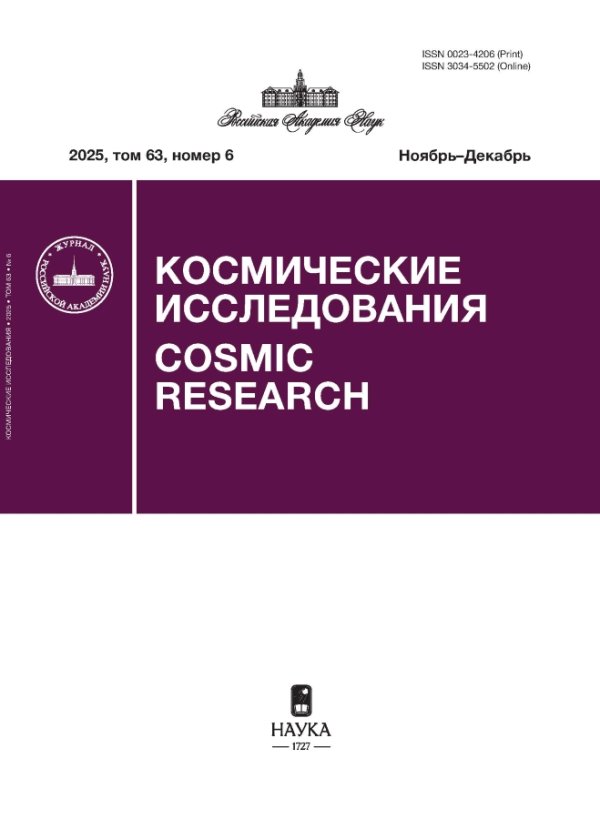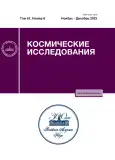The Significance of Input Features for Domain Adaptation of Spacecraft Data
- Authors: Karimov E.Z.1,2, Myagkova I.N.2, Shirokiy V.R.2, Barinov O.G.2, Dolenko S.A.3
-
Affiliations:
- Faculty of Physics, Moscow State University, 119991, Moscow, Russia
- Skobeltsyn Institute of Nuclear Physics, Moscow State University, 119991, Moscow, Russia
- Skobeltsyn Institute of Nuclear Physics, Lomonosov Moscow State University
- Issue: Vol 61, No 6 (2023)
- Pages: 530-537
- Section: Articles
- URL: https://journals.rcsi.science/0023-4206/article/view/231834
- DOI: https://doi.org/10.31857/S0023420623600125
- EDN: https://elibrary.ru/CBGXUK
- ID: 231834
Cite item
Full Text
Abstract
The problem of improving the neural network forecast of geomagnetic index Dst under conditions in which the input data for such a forecast are measured by two spacecraft, one of which is close to the end of its life cycle, and the data history of the other is not yet enough to construct a neural network forecast of the required quality. For an efficient transition from the data of one spacecraft to the data of another, it is necessary to use methods of domain adaptation. This paper tests and compares several data translation methods. Also, for each translated attribute, an optimal set of parameters for its translation were found, which further reduces the difference between domains. The paper shows that the use of domain adaptation methods with the selection of significant features can improve the forecast compared to the results of using untranslated data.
About the authors
E. Z. Karimov
Faculty of Physics, Moscow State University, 119991, Moscow, Russia; Skobeltsyn Institute of Nuclear Physics, Moscow State University, 119991, Moscow, Russia
Email: Karimov.ez19@physics.msu.ru
Россия, Москва; Россия, Москва
I. N. Myagkova
Skobeltsyn Institute of Nuclear Physics, Moscow State University, 119991, Moscow, Russia
Email: Dolenko@srd.sinp.msu.ru
Россия, Москва
V. R. Shirokiy
Skobeltsyn Institute of Nuclear Physics, Moscow State University, 119991, Moscow, Russia
Email: Dolenko@srd.sinp.msu.ru
Россия, Москва
O. G. Barinov
Skobeltsyn Institute of Nuclear Physics, Moscow State University, 119991, Moscow, Russia
Email: Dolenko@srd.sinp.msu.ru
Россия, Москва
S. A. Dolenko
Skobeltsyn Institute of Nuclear Physics, Lomonosov Moscow State University
Author for correspondence.
Email: dolenko@srd.sinp.msu.ru
Moscow, 119991 Russia
References
- Daglis I.A. Space Storms and Space Weather Hazards. Dordrecht: Kluwer Academic Publishers, 2001.
- Cole D.G. Space weather: Its effects and predictability // Space Science Reviews. 2003. V. 107. P. 295–302. https://doi.org/10.1023/A:1025500513499
- Vassiliadis D. Forecasting space weather // Space Weather: Physics and Effects. Berlin; Heidelberg: Springer Praxis Books, 2007. P. 403–425. https://doi.org/10.1007/978-3-540-34578-7_14
- Kudela K. Space weather near Earth and energetic particles: selected results // J. Physics: Conf. Series. 2013. V. 409. Iss. 1. Art. ID. 012017. https://doi.org/10.1088/1742-6596/409/1/012017
- Schrijver C.J., Kauristie K., Aylward A.D. et al. Understanding space weather to shield society: A global road map for 2015–2025 commissioned by COSPAR and ILWS // Advances in Space Research. 2015. V. 55. Iss. 12. P. 2745–2807. https://doi.org/10.1016/j.asr.2015.03.023
- McGranaghan R.M., Camporeale E., Georgoulis M. et al. Space Weather research in the Digital Age and across the full data lifecycle: Introduction to the Topical Issue // J. Space Weather and Space Climate. 2021. V. 11. Art. ID. 50. https://doi.org/10.1051/swsc/2021037
- Лазутин Л.Л. Мировые и полярные магнитные бури / Под ред. проф. Ю.И. Логачева. М.: МГУ, 2012. 214 с.
- Qiu Q., Fleeman J.A., Ball D.R. Geomagnetic disturbance: A comprehensive approach by American electric power to address the impacts / IEEE Electrification Magazine. 2015. V. 3. Iss. 4. P. 22–33. https://doi.org/10.1109/MELE.2015.2480615
- Белаховский В.Б., Пилипенко В.А., Сахаров Я.А. и др. Рост геомагнитно-индуцированных токов во время корональных выбросов массы и высокоскоростных потоков солнечного ветра геомагнитных бурь в 2021 году // Изв. РАН. Сер. Физическая. 2023. Т. 87. № 2. С. 271–277. , EDN: AITPFOhttps://doi.org/10.31857/S0367676522700478
- Friedel R.H., Reeves W.G.P., Obara T. Relativistic electron dynamics in the inner magnetosphere: A review // J. Atmospheric and Solar-Terrestrial Physics. 2002. V. 64. Iss. 2. P. 265–283. https://doi.org/10.1016/S1364-6826(01)00088-8
- Kataoka R., Miyoshi Y. Average profiles of the solar wind and outer radiation belt during the extreme flux enhancement of relativistic electrons at geosynchronous orbit // Annales Geophysicae. 2008. V. 26. Iss. 6. P. 1335–1339. https://doi.org/10.5194/angeo-26-1335-2008
- Мягкова И.Н., Шугай Ю.С., Веселовский И.С. и др. Сравнительный анализ влияния рекуррентных высокоскоростных потоков солнечного ветра на радиационное состояние околоземного космического пространства в апреле–июле 2010 года // Астрон. вестн. 2013. Т. 47. № 2. С. 141–155. https://doi.org/10.7868/S0320930X13020060
- Белов А.В., Виллорези Дж., Дорман Л.И. и др. Влияние космической среды на функционирование искусственных спутников Земли // Геомагнетизм и аэрономия. 2004. Т. 44. № 4. С. 502–510.
- Романова Н.В., Пилипенко В.А., Ягова Н.В. и др. Статистическая связь частоты сбоев на геостационарных спутниках с потоками энергичных электронов и протонов // Косм. исслед. 2005. Т. 43. № 3. С. 186–193.
- Summers D., Stone S. Analysis of radiation belt “killer” electron energy spectra // J. Geophysical Research: Space Physics. 2022. V. 127. Iss. 9. Art. ID. e2022JA030698. https://doi.org/10.1029/2022JA030698
- Akasofu S.-I., Chapman S. Solar-Terrestrial Physics. Oxford: Clarendon Press, 1972. 901 p.
- Riazantseva M.O., Dalin P.A., Dmitriev A.V. et al. A multifactor analysis of parameters controlling solar wind ion flux correlations using an artificial neural network technique // J. Atmospheric and Solar-Terrestrial Physics. 2002. V. 64. Iss. 5–6. P. 657–660. https://doi.org/10.1016/S1364-6826(02)00026-3
- Burton R.K., McPherron R.L., Russell C.T. An empirical relationship between interplanetary conditions and Dst // J. Geophysical Research. 1975. V. 80. P. 4204–4214.
- Ефиторов А.О., Мягкова И.Н., Широкий В.Р. и др. Прогнозирование Dst-индекса, основанное на методах машинного обучения // Косм. исслед. 2018. Т. 56. № 6. С. 353–364. https://doi.org/10.31857/S002342060002493-0
- Мягкова И.Н., Широкий В.Р., Владимиров Р.Д. и др. Прогнозирование значений геомагнитного индекса Dst при помощи адаптивных методов // Метеорология и гидрология. 2021. № 3. С. 38–46. https://doi.org/10.52002/0130-2906-2021-3-38-46
- Myagkova I., Shiroky V., Dolenko S. Prediction of geomagnetic indexes with the help of artificial neural networks // E3S Web of Conferences. 2017. V. 20. Art. ID. 02011. 7 p. https://doi.org/10.1051/e3sconf/20172002011
Supplementary files















